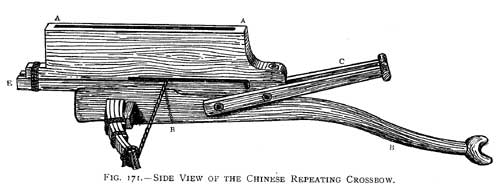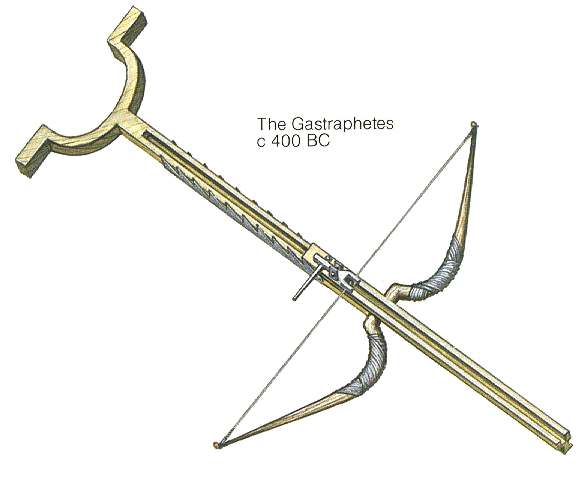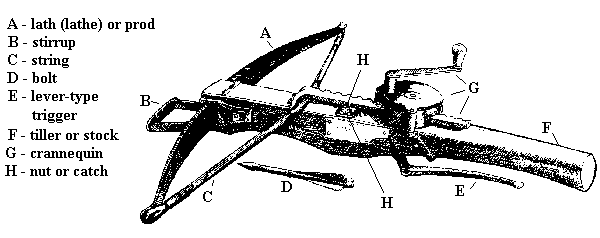Crossbow is called by many names most of wich is derived by term Balista. Balista was great siege engine resembling a crossbow, though much larger in size.
Arbalist - Latin language term for crossbow.
Arbalète - Term for crossbow in France and Belgium.
Armbrust - German language term for crossbow.
Arrow - Projectile consisting of shaft with pointed head (arrowhead), vanes for flight-stabilazing and nock. Term arrow is used by modern crossbow manufactureres.
Back of bow - The side of bow facing target.
Barreled crossbow - Crossbow having turbular barrel; used to shoot balls; also called slurbow.
Bastard string - String to brace a crossbow for installation the bowstring.
Belly of bow - The side of bow facing shooter.
Bolt - Short heavy projectile for crossbow; several times heavier than a arrow.
Bowstring - String used on crossbow to transfe energy fros bow to projectile.
Braced height - Distance between braced bowstring and belly side of riser, measured from the bowstring's centre.
Broadhead - Type of arrowhead, used mainly for hunting.
Bullet crossbow - Crossbow designed to shoot bullets.
Butt - The rearmost portion of the tiller.
Center shot - Crossbow lath designed so that the projectile passes through its center, centre-shot crossbows often have two separate limbs.
Cock - To draw bowstring from braced position to latched position.
Cocking lugs - Metal pins on crossbow for anchoring bending lever, cranequin or goat's foot.
Cocking peg - Peg required to set some crossbow trigger mechanisms prior to cocking.
Cocking ring - Metal ring bound to the front of the lath to anchor bending lever.
Cockscombing - Method of serving sometimes used on loops of crossbow bowstrings.
Cord and pulley - Cocking aid consisting of cord with ends attached to crossbow butt and user's belt running through a pulley attached to bowstring.
Cranequin - Cocking device using rack and pinion.
Crossbow - Archery weapon consisting of a bow mounted to a rigid stock.
Dry fire - To release cocked bowstring without projectile.
Endcap - protective cap to protect rear of bolt.
Goats foot - Two-piece hinged cocking lever designed to pull bowstring from behind.
Latch - Mechanism in the tiller of a crossbow to hold the bowstring in the cocked position, which also releases the bowstring when the trigger is released.
Lath - Bow portion of a crossbow storing motive energy for propelling projectile.
Limb - Portion o lath left or right from center.
Manubalista - Smaller form of ballista.
Nock - Groove on the back of a bolt or arrow into which the bow string is placed.
Nose - Forward end of crossbow.
Power stroke - Distance between braced and cocked string positions.
Prod - Bow portion of crossbow.
Quiver - Container for carrying arrows or bolts.
Riser - Non-bending centre of bow.
Safety - Device used to prevent crossbow from shooting unintentionally.
Spanning - Physical act of cocking a crossbow.
Stirrup - Device for holding the crossbow with feet while cocking.
Stock (or tiller) - Portion of the crossbow to which all other components are attached and by which it is held.
Track - Grooved portion of the crossbow between the bow and latch where the projectile rides.
Windlass - Crossbow cocking device using a system of pulleys and cords.
Medieval crossbow parts:
Modern compound crossbow parts:



















